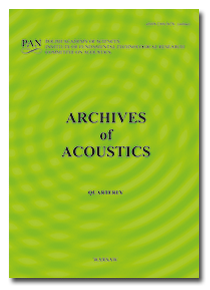Archives of Acoustics,
31, 4(S), pp. 23-28, 2006
Modal analysis of the human tympanic membrane of middle ear using the finite-element method
This paper provides a theoretical vibrations model of tympanic membrane constructed and
solved using the finite-element method. This method is an appropriate tool to analyze the
middle-ear vibrations because it enables modeling in details the complicated shape of the
middle-ear and, moreover, and allows to calculate the distribution of vibrations stimulated by
sinusoidal signals. The number of the 3-dimensional tetrahedral elements was assumed to be
591 and material properties used were based on data available in the literature. This model
has a uniform density of $1.2 \cdot 10^3$ kg/m$^3$, an area of $70\cdot 10^{−6}$ m$^2$, a depth of $1.54 \cdot 10^{−3}$ m
at the umbo, a mean thickness of $1.32 \cdot 10^{−4}$ m, and a Poisson’s ratio 0.3. Constrains were
accomplished by two different springs, linear and torsional. The results obtained are compared
with their counterparts scattered in the literature.
solved using the finite-element method. This method is an appropriate tool to analyze the
middle-ear vibrations because it enables modeling in details the complicated shape of the
middle-ear and, moreover, and allows to calculate the distribution of vibrations stimulated by
sinusoidal signals. The number of the 3-dimensional tetrahedral elements was assumed to be
591 and material properties used were based on data available in the literature. This model
has a uniform density of $1.2 \cdot 10^3$ kg/m$^3$, an area of $70\cdot 10^{−6}$ m$^2$, a depth of $1.54 \cdot 10^{−3}$ m
at the umbo, a mean thickness of $1.32 \cdot 10^{−4}$ m, and a Poisson’s ratio 0.3. Constrains were
accomplished by two different springs, linear and torsional. The results obtained are compared
with their counterparts scattered in the literature.
Keywords:
finite-element model, modal analysis.
Full Text:
PDF
Copyright © Polish Academy of Sciences & Institute of Fundamental Technological Research (IPPT PAN).





